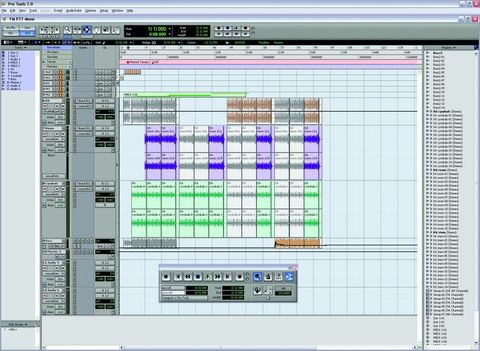As it is in HD form, Pro Tools is one of the most common sights in modern professional studios. Yet its semi-professional version (LE) faces stiff competition from a number of equally or better specified audio/MIDI packages.
To complicate matters further, the M-Audio compatible version (M-Powered) has introduced another solution with very similar features to LE. Confused? Maybe version 7 will clear things up a bit, as well as make up for some of that lost ground.
Overview
Over the last year we've seen some considerable releases from Digidesign, with the M-Powered software and the Mbox2 both indicating continued support for native software. However, with version 6 upgrades reaching 6.9, the appearance of version 7 does feel a little overdue.
Although included free with new LE hardware packages, this version is a pay-for upgrade for existing users (£53) available as a download or for an extra £10 on CD. At this stage version 7 doesn't include the additional software bundle that comes with Digidesign hardware.
But it does include the current DigiRack plug-ins (including EQ III) and Free Bomb Factory plug-ins. Strangely the latest freebie (Dynamics III) isn't within the installer, so you'll have to download that separately.
Also worthy of note is the requirement for Mac users to be on OS X 10.4. For PC users the only tested system is XP SP2, which is what I used for the review.
Like previous LE versions, 7 is limited to 32 audio tracks (24-bit, 96kHz) and 256 MIDI tracks. For the specification junkies, however, there are further improvements.
Instrument tracks make a first appearance, allowing integrated MIDI control of instrument plug-ins within one track. Also, you'll find there are now 10 sends per track and 32 internal busses.
File support has been extended to include REX and ACID, and you get real-time MIDI processing. But most significant for those pushing their systems to the limit, RTAS efficiency has been improved, with dual-processor allocation finding its way into the hardware set up.
For M-Powered users version 7 is a free upgrade (downloadable). It adds more M-Audio interfaces to the growing number, including Transit, creating possibly the most portable PT option. It also includes the multiple processor support and everything else mentioned above.
Same old Pro Tools?
Surprisingly, aside from a new splash screen, Pro Tools 7 looks a lot like the last version - 6. But with a new session up and running, the subtle changes are there to be seen.
Firstly, the menu structure has gone through quite a rethink. I suspect this is long overdue, and although some of it remains the same, the new main categories (including view, track, region and event) certainly bear a closer resemblance to the way people use the application.
The new track creation option lets you create all of your tracks in the order you want them to appear in one easy step.
Further workflow improvements include dragging audio directly into the edit window from the desktop, dragging of multiple regions into a single track, copying and moving of sends, and selection of region groups. You'll also find 'tool tips' helps you identify icons and buttons.
Clearly though for Digidesign, the big emphasis with PT 7 concerns its handling of MIDI. One new inclusion is the track-based and region-based real-time properties. These allow you to tweak quantize, duration, delay, velocity and transpose on the fly for a whole track or individual regions.
None of these parameter changes show up graphically, though, unless you check the appropriate box in the preferences.
You can also use sample-based rather than tick-based MIDI tracks. Here the MIDI data is anchored to its region rather than the bars / beats grid of the song, and so it doesn't shift with tempo changes.
Other updates
Further MIDI improvements include mirrored editing whereby edits to a MIDI region can be copied to all other MIDI regions of the same name.
You'll find improved groove quantize options and general improvements to note handling, including a 'remove duplicate notes' option.
All the action takes place in the one edit screen, and especially when editing MIDI I made much use of the toggle zoom option.
Version 7 is an interesting upgrade. The MIDI side continues to improve and audio handling remains unmatched in my opinion.
Even so, Digi have concentrated on improving the operational side of the package, rather than investing in new plug-ins or even software instruments.
The EQ III, advertised as a new plug-in, has been around as a free download for ages, and the Dynamics III isn't even included in the installer. Even so, there's plenty to be positive about, and at £53 it's a bargain.
Overall though, I'm left with the impression that the gaps are closing between the various different versions, and that the arguments for owning a full HD system are becoming less and less. All they need to do now is sort out full automatic plug-in delay compensation, oh yes, and up that audio track count.


